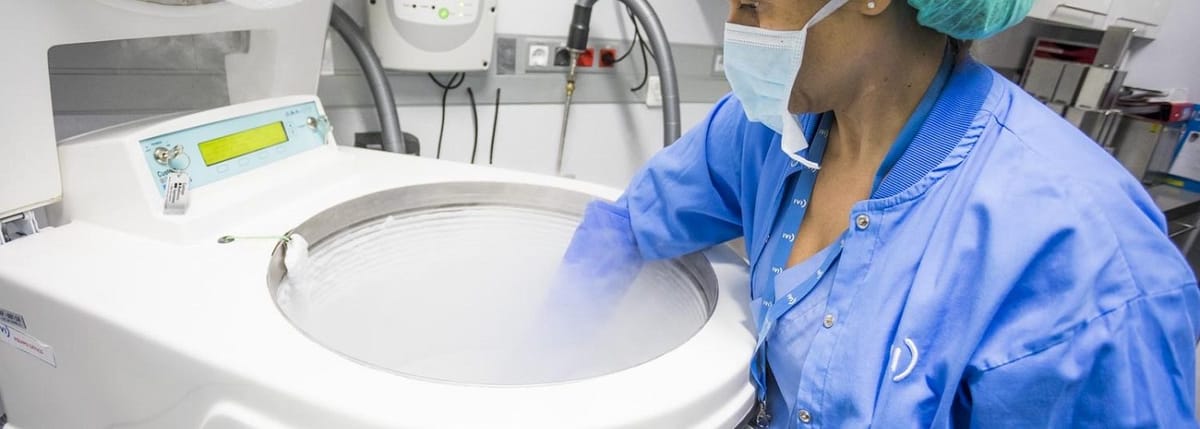
The current global pandemic, coupled with the collapse of health care, is forcing people to postpone the desire to have children in the face of widespread uncertainty. This is already reflected in many countries, which have recorded a drop in the birth rate in 2020 and expect an even more drastic drop in 2021.
In the light of this worrying situation, assisted reproduction takes on special importance, as the cryopreservation of gametes or embryos makes it possible to postpone motherhood with full guarantees. At IVI we work under maximum safety conditions to ensure fertility preservation is a totally effective technique.
Successful transfer of vitrified embryos
Covid-19 forced ongoing treatments to be put on hold for all patients in March 2020. Many embryos that were to be transferred “fresh” had to be vitrified, in order to preserve them until they could be safely implanted.
When it comes to women who must undergo assisted reproduction treatment to become mothers, time is often not on their side and fertility preservation emerges as one of the best options to postpone motherhood plans without reducing the chances of success.
Ensuring the success of vitrified embryo transfers is a complex objective on which IVI works every day. Dr. Ana Cobo, Director of IVI’s Cryobiology Unit, is a recognised specialist in this field, as in 2008 she led a pioneering research project on egg vitrification at global level. Moreover, this work is listed as one of the 25 most relevant in history, according to the American Society for Reproductive Medicine (ASRM), a global benchmark in the field.
For this study, a number of oocytes were selected from the same donor, half of which were vitrified and thawed after one hour, while the other half remained in the incubator for the same period of time. Once the oocytes were devitrified, they were fertilised along with the fresh ones, at the same time with the same semen. This allowed the assessment of the development of embryos generated from vitrified and fresh oocytes under the same conditions, comparing fertilisation rates, early division and development to blastocyst. Dr. Cobo speaks of very positive results: “It was a pleasant surprise to find that the results obtained were similar for these 3 parameters, which prompted us to start vitrifying donor oocytes with very encouraging results for the evolution of future egg banks”.
Message of reassurance
In the current context, these findings give hope to many women and couples who, with the irruption of Covid-19, wish to postpone their dream of having children, whether they are considering vitrifying oocytes or have already done so. “I would like to convey a message of reassurance to all patients who have had their embryos vitrified and to those who will do so”, explained Dr. Cobo.
In turn, vitrification and its advances have contributed to increasing the safety of expectant mothers and their babies by greatly reducing multiple pregnancies and the risks associated with them. This is due to the fact that, once fertilised, the embryos can be preserved with the same quality, which is the reason for opting for a single embryo when transferring.
Safety in IVI’s storage
Another reason for optimism in the face of the pandemic is the safety IVI guarantees in long-term embryo storage, as it has state-of-the-art cryogenic rooms equipped with self-powered liquid nitrogen tanks. These tanks have continuous monitoring systems giving real-time information on the temperature of gametes and embryos, and are able to issue an alert in the event of any eventuality.
Regarding the impact of COVID-19 in assisted reproduction treatments, doubts arise as to whether there is a possibility of transmission through these processes. As regards the possible transmission of the virus after the transfer of frozen embryos, although there is no extensive knowledge and experience on this matter, IVI does have extensive experience with patients infected with other viruses such as Hepatitis or HIV.
Indeed, in 2012 a paper was published analysing the probability of virus infection after the transfer of embryos from patients infected with these viruses, concluding that this probability is practically non-existent, among other things, due to technical aspects inherent to the vitrification and devitrification procedure, which would make it possible to eliminate viral particles if they were present, and also due to the slim chance of finding viral particles in gametes and embryos.
“The level of biological containment required to work with samples from patients infected with these viruses, including COVID-19, is very high and IVI clinics are very well prepared to offer patients the best guarantees and safety on their road to motherhood”, concluded Dr. Cobo.
Cryopreservation before the age of 35
Beyond the situation caused by Covid-19, cryopreservation is an essential part of assisted reproduction, with high success rates achieved thanks to the optimisation of this technique. However, despite its efficacy, the importance of vitrifying the gametes at an early age cannot be overlooked, as currently 90% of the indications for oocyte vitrification are for non-medical reasons.
In the last decade, the number of IVI patients over 40 years of age has increased by 74% and they now represent one of the most relevant groups when it comes to undergoing reproductive treatments. For this reason, Dr. Cobo stresses this recommendation: “It is important to encourage women and raise awareness about the need to vitrify their eggs before the age of 35, as from this age their fertility begins to decrease and with it the chances of reproductive success”.





Comments are closed here.